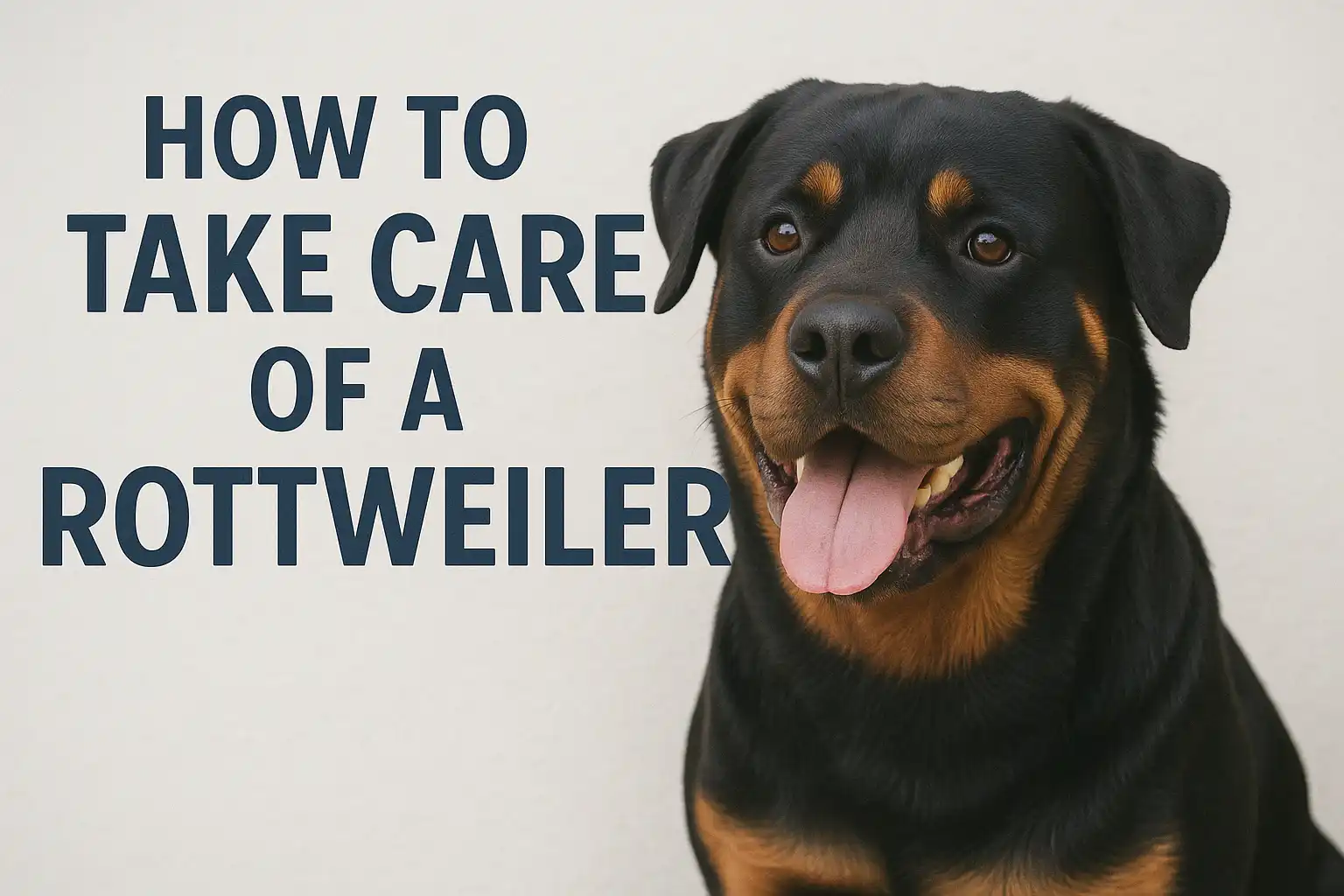Caring for a Rottweiler goes beyond the basics – these powerful companions need structured exercise, proper nutrition, and consistent training to thrive. This comprehensive guide covers everything you need to know about how to take care of a Rottweiler from a seasoned owner’s perspective.
When I brought home my first Rottweiler, Zeus, I had no idea what I was getting myself into. These magnificent dogs are often misunderstood – powerful yet gentle, protective yet affectionate. Learning how to take care of a Rottweiler properly transformed not just Zeus’s life, but mine as well. Whether you’re a new Rottie parent or looking to improve your care routine, this guide will walk you through everything you need to know about raising a happy, healthy Rottweiler.
Understanding Rottweiler Needs
Rottweilers are working dogs with deep-rooted instincts and specific needs. Learning how to take care of a Rottweiler starts with understanding what makes these dogs tick. According to the American Kennel Club, Rottweilers have a working heritage that dates back to the Roman Empire, which explains their strong drive for having jobs and consistent routines. Their history as cattle drivers and guardians shapes their behavior and requirements significantly.”
What Are the Basic Requirements for Rottweilers?
Rottweilers need more than just food and shelter. These powerful dogs require:
- A secure, fenced yard or regular access to spacious areas
- Mental stimulation through tasks and puzzles
- Consistent leadership and boundaries
- Companionship (they don’t do well when left alone for long periods)
- Regular veterinary care tailored to large breed needs
- Appropriate housing with temperature control (they’re sensitive to extreme heat)
- Quality equipment like sturdy leashes, collars, and appropriately sized beds
When I first brought Zeus home, I underestimated his need for structure. Rottweilers thrive when they have clear expectations and consistent routines. They’re not the kind of dog that can adapt to a chaotic household – they need to know what’s happening and when it’s happening.
Living space is particularly important when learning how to take care of a Rottweiler. While they don’t necessarily need a mansion, they do need enough space to move comfortably. A cramped apartment can work if you’re committed to multiple daily outings, but these dogs definitely benefit from having some yard space to patrol. More important than size is security – Rottweilers are strong and intelligent, capable of testing boundaries both literal and figurative. A secure fence at least 6 feet tall is essential if you plan to have an outdoor area for your Rottie.
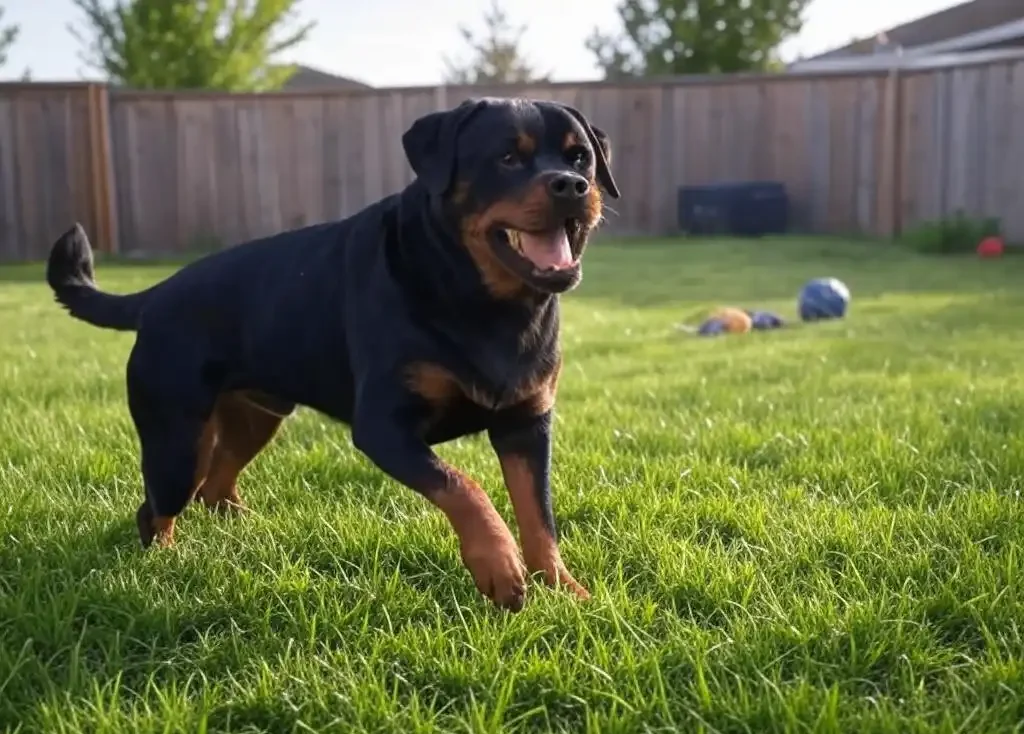
How Much Exercise Do Rottweilers Need?
Knowing how to take care of a Rottweiler means understanding their substantial exercise needs. These dogs require:
- 1-2 hours of physical activity daily
- A mix of walking, running, and play
- Mentally stimulating exercises like tracking or nosework
- Age-appropriate exercise (puppies need shorter, more frequent sessions)
- Weather-appropriate adjustments (they’re sensitive to heat)
- Regular weight-bearing exercise for muscle maintenance
- Varied routines to prevent boredom
I learned this lesson the hard way with Zeus. On days when we skipped his exercise, he’d find his own “projects” – usually involving my couch cushions or garden beds. A tired Rottweiler is a well-behaved Rottweiler. However, be careful not to over-exercise puppies, as this can damage their developing joints.
Creating an exercise schedule is essential when learning how to take care of a Rottweiler properly. For adult Rottweilers, I recommend:
- Morning: 30-minute brisk walk or jog
- Midday: 15-minute training session or puzzle toy
- Evening: 45-minute activity (fetch, swimming, hiking)
- Weekend: Longer adventures like hiking or beach trips
Zeus particularly enjoys swimming, which provides excellent exercise without stressing his joints. For a detailed breakdown of age-appropriate activities and how to create balanced exercise routines for your Rottweiler throughout the seasons, explore our complete Rottweiler exercise requirements guide.
Nutrition for Rottweilers
Proper nutrition is crucial when learning how to take care of a Rottweiler. These large, muscular dogs have specific dietary needs that differ from other breeds.
What Should You Feed a Rottweiler?
Rottweilers thrive on:
- High-quality protein sources (25-30% of their diet)
- Controlled fat content (12-16% is ideal)
- Joint-supporting nutrients like glucosamine and chondroitin
- Calcium and phosphorus in the correct ratios for bone health
- Limited fillers like corn, wheat, and soy
- Omega-3 fatty acids for skin, coat, and joint health
- Appropriate caloric intake adjusted for age, activity level, and weight
When Zeus was diagnosed with mild hip dysplasia at age four, our vet immediately recommended adjusting his diet. For specific recommendations and reviews of top quality options, check our guide to the best dog food for Rottweilers that support joint health and overall wellbeing
When learning how to take care of a Rottweiler through different life stages, their nutritional needs will change. Puppies need specially formulated large-breed puppy food that controls growth rate while providing ample nutrition. Growing too quickly can predispose Rottweilers to joint problems later in life. Adult Rottweilers typically need 4-6 cups of high-quality food daily, divided into two meals, though this varies based on the individual dog’s metabolism, activity level, and age.
Weight management is crucial for Rottweilers. These dogs are prone to obesity, which can exacerbate joint issues and lead to a host of other health problems. You should be able to feel but not see your Rottweiler’s ribs, and they should have a visible waist when viewed from above. If your Rottweiler starts gaining excess weight, reduce portions slightly and increase exercise rather than switching to a drastically different diet that might lack essential nutrients.

How Often Should You Feed a Rottweiler?
Feeding schedule is an important aspect of how to take care of a Rottweiler:
- Puppies (8-12 weeks): 4 meals daily
- Puppies (3-6 months): 3 meals daily
- Puppies (6-12 months): 2 meals daily
- Adults: 2 meals daily with consistent timing
- Seniors: 2 smaller meals, potentially with adjusted calories
Never free-feed a Rottweiler – they’re prone to bloat, a potentially fatal condition that can be triggered by eating too quickly or too much at once. Using slow-feeder bowls and maintaining consistent meal times helps reduce this risk. I always ensure Zeus has at least an hour of calm time after meals before any vigorous exercise.
Grooming Rottweilers
Though they have short coats, Rottweilers still need regular grooming. Learning how to take care of a Rottweiler includes establishing a good grooming routine.
How to Groom a Rottweiler Properly?
Proper Rottweiler grooming includes:
- Weekly brushing with a rubber curry brush or grooming mitt
- More frequent brushing during seasonal shedding periods
- Monthly baths (unless they get particularly dirty)
- Regular nail trimming (every 3-4 weeks)
- Weekly teeth cleaning with dog-safe toothpaste
- Ear checks and cleaning as needed
I remember being surprised by how much Zeus shed despite his short coat. During shedding season (typically spring and fall), daily brushing makes a huge difference in keeping your home hair-free. Brushing also distributes skin oils and gives you a chance to check for any lumps, bumps, or skin issues.
What Are the Best Grooming Tools for Rottweilers?
For effective Rottweiler grooming, you’ll need:
- A rubber curry brush or grooming mitt for regular brushing
- A de-shedding tool for seasonal shedding periods
- Dog-specific shampoo formulated for sensitive skin
- Nail clippers designed for large dogs
- Canine toothbrush and toothpaste
- Ear cleaning solution recommended by your vet
Investing in quality grooming tools made my life much easier. The right de-shedding tool can remove the undercoat without damaging the topcoat, and proper nail clippers make trimming less stressful for both you and your dog. I learned how to take care of a Rottweiler’s grooming needs through trial and error – start slow and make it a positive experience with treats and praise.
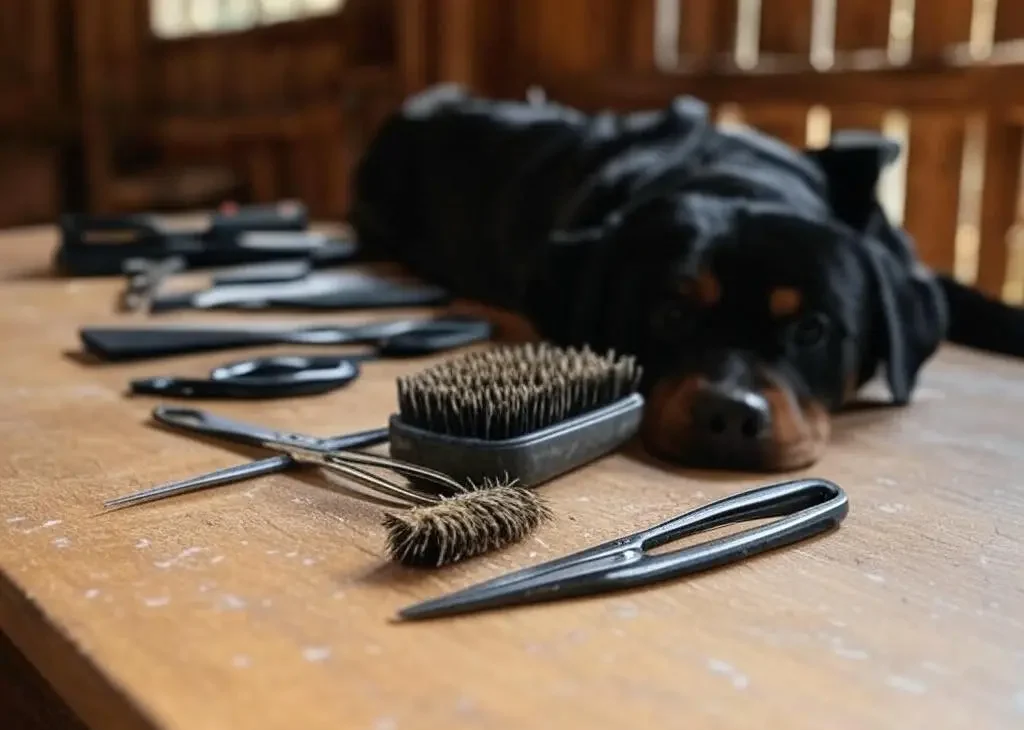
Training Rottweilers
Training is perhaps the most critical aspect of how to take care of a Rottweiler. These intelligent, powerful dogs need clear boundaries and consistent guidance.
How to Train a Rottweiler Effectively?
Effective Rottweiler training involves:
- Starting early (ideally at 8 weeks)
- Consistency in commands and expectations
- Positive reinforcement techniques
- Clear boundaries and rules
- Regular, short training sessions (15-20 minutes)
- Socialization with various people, animals, and environments
- Patience and calm, assertive energy
- Progressive training that builds on existing skills
The most important lesson I learned with Zeus was the power of consistency. Rottweilers test boundaries – they’re intelligent and will quickly figure out if rules are flexible. When I said “off” the furniture, it needed to mean “off” every single time, not just when company was over or when he was muddy.
A structured training progression is essential when learning how to take care of a Rottweiler properly. I recommend this sequence:
- Basic commands: sit, stay, come, down, leave it
- Leash manners: loose-leash walking, heel, proper greetings
- Impulse control: waiting at doors, staying until released, ignoring distractions
- Advanced commands: place, drop it, go to bed, retrieve specific items
- Public behavior: reliable responses in different environments
Zeus was particularly stubborn about “come” when distracted by interesting scents. I discovered that using high-value treats (like small pieces of cooked chicken) and practicing in gradually more distracting environments was key to reliable recall. Teaching your Rottweiler to respond to commands regardless of distractions isn’t just about convenience – it’s a safety issue for a dog of this size and strength. Understanding how to take care of a Rottweiler includes recognizing that proper training is non-negotiable for their wellbeing and public perception.
What Are Common Training Techniques for Rottweilers?
When learning how to take care of a Rottweiler, these training approaches work best:
- Reward-based training with high-value treats
- Clicker training for precise timing
- “Nothing in life is free” approach (they work for rewards)
- Crate training for safety and security
- Leash training with properly fitted equipment
- Socialization “field trips” to new environments
One technique that worked especially well with Zeus was the “nothing in life is free” approach. He had to sit before meals, wait at doors, and perform a command before play sessions. This established me as the leader and gave him the structure he craved. Rottweilers respect consistent leadership – they don’t respond well to harsh methods or inconsistent expectations.
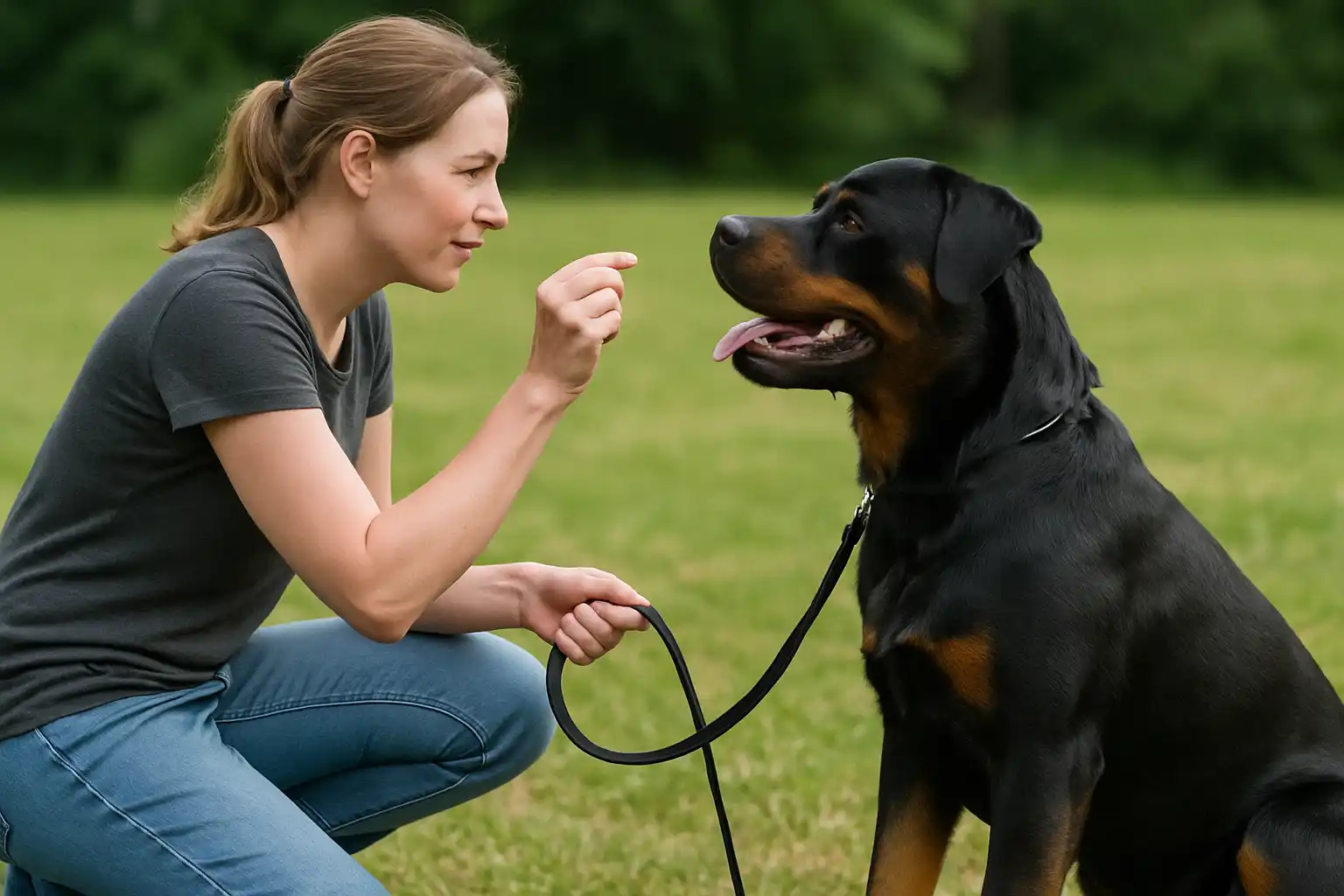
Health Care for Rottweilers
Understanding common health issues is crucial when learning how to take care of a Rottweiler. The Rottweiler Health Foundation reports that approximately 20% of Rottweilers develop hip dysplasia, making regular health screenings essential for this breed.
What Are Common Health Issues in Rottweilers?
Rottweilers are predisposed to certain conditions:
- Hip and elbow dysplasia
- Aortic stenosis (heart condition)
- Osteosarcoma (bone cancer)
- Cruciate ligament tears
- Entropion (eyelid abnormality)
- Bloat/gastric torsion
- Hypothyroidism
- Von Willebrand’s disease (bleeding disorder)
- Progressive retinal atrophy
- Allergies and skin conditions
When Zeus started showing subtle signs of joint discomfort at age three, I didn’t wait to see if it would resolve on its own. Early intervention is critical for these conditions. For an in-depth look at symptoms, treatments, and prevention strategies, see our comprehensive guide to Rottweiler health problems
Understanding the early warning signs of common Rottweiler health issues is crucial when learning how to take care of a Rottweiler. For joint problems, watch for subtle changes in movement – reluctance to jump, stiffness after rest, or a slight change in gait. With bloat, a life-threatening emergency, look for restlessness, unproductive attempts to vomit, and abdominal distension. For heart conditions, monitor for exercise intolerance, coughing, or unusual fatigue.
Preventative measures are your best defense when learning how to take care of a Rottweiler’s health. Consider these preventative approaches:
- Maintain healthy weight to reduce joint stress
- Feed from elevated bowls to reduce risk of bloat
- Provide joint supplements from an early age
- Schedule annual heart checks with a veterinary cardiologist
- Consider pet insurance to manage potential treatment costs
- Implement regular at-home health checks (teeth, ears, skin)
Zeus developed a hot spot on his hind leg one summer that quickly grew from a small irritation to a large, painful area. I learned to check his skin regularly, especially in hot, humid weather, and to address any abnormalities immediately. Rottweilers’ short coats can hide skin issues until they become serious, making regular inspection an important part of how to take care of a Rottweiler properly.
How Often Should You Take Your Rottweiler to the Vet?
Regular veterinary care is essential for Rottweilers:
- Puppies: Initial visits for vaccines every 3-4 weeks until 16 weeks
- Puppies: Spay/neuter discussion around 6 months
- Adults: Annual wellness exams and vaccines
- Seniors (7+): Bi-annual exams with bloodwork
- Any time you notice changes in behavior, appetite, or movement
Finding a vet who understands large breeds made a huge difference in Zeus’s care. Our vet emphasized preventative measures specifically for Rottweilers, including joint supplements from an early age and regular weight checks. Knowing how to take care of a Rottweiler means partnering with healthcare professionals who understand the breed’s specific needs.
Socialization for Rottweilers
Proper socialization is non-negotiable when learning how to take care of a Rottweiler. These naturally protective dogs need extensive exposure to different situations to develop appropriate responses.
How to Socialize a Rottweiler with Other Dogs?
Socializing Rottweilers with other dogs requires:
- Starting as early as possible (after appropriate vaccinations)
- Controlled introductions in neutral territory
- Positive associations through treats and praise
- Reading your dog’s body language and respecting limits
- Gradually increasing difficulty of interactions
- Consistent reinforcement of good behavior
- Managing interactions proactively
- Creating success scenarios rather than testing limits
I made sure Zeus had regular, positive interactions with other dogs from puppyhood. We started with calm, well-socialized adult dogs and gradually worked up to more energetic playmates. Even as an adult, he continues to benefit from regular “doggy playdates” with familiar friends.
The socialization window for puppies closes around 16 weeks, making early exposure crucial when learning how to take care of a Rottweiler puppy. However, even adult Rottweilers can improve their social skills with the right approach. With Zeus, I found that parallel walking was an excellent technique for introducing him to new dogs – walking side by side with another dog, maintaining some distance at first, then gradually moving closer as both dogs remain calm.
Understanding canine body language is essential for successful socialization. Signs of stress in your Rottweiler might include:
- Stiff body posture
- Raised hackles
- Whale eye (showing whites of the eyes)
- Lip licking or yawning when not tired
- Turning away or avoiding interaction
- Low growling (a communication, not necessarily aggression)
Learning to recognize these signals and intervening early prevents negative experiences that could set back your socialization progress. Remember that not every Rottweiler needs to be best friends with every dog they meet – a neutral, calm response to other dogs is a perfectly acceptable goal when learning how to take care of a Rottweiler’s social development.

What Techniques Help in Socializing Rottweilers?
Effective socialization techniques include:
- Puppy socialization classes with qualified trainers
- Structured walks in various environments
- Gradual exposure to different people, sounds, and surfaces
- Using a “watch me” command to redirect attention
- Rewarding calm behavior in new situations
- Never forcing interactions if the dog shows fear
One technique that worked well for Zeus was the “look at that” game. Whenever he noticed something new or potentially concerning, I’d mark the moment he looked at it with a “yes” and reward him. This taught him that new things predict good outcomes rather than something to fear or guard against.
Bonding with Your Rottweiler
The bond you build with your Rottweiler will determine the success of your relationship. Learning how to take care of a Rottweiler includes investing in this connection.
How to Build a Strong Bond with Your Rottweiler?
Building a strong bond requires:
- Consistent, fair leadership
- Regular one-on-one time
- Understanding and respecting their communication
- Meeting their physical and mental needs
- Being their safe space during stressful situations
- Celebrating their successes, no matter how small
The bond I’ve built with Zeus didn’t happen overnight. It came from countless training sessions, walks in the rain when I’d rather have stayed home, and being there for him during thunderstorms that terrified him. Your Rottweiler needs to know that you’re reliable, consistent, and trustworthy.
What Activities Can Strengthen Your Relationship with a Rottweiler?
Bond-building activities include:
- Training for dog sports like obedience, tracking, or agility
- Regular hiking or swimming adventures
- Puzzle games that you solve together
- Massage and gentle grooming sessions
- Trick training for mental stimulation
- Simply spending quiet time together
- Carting or weight pulling (traditional Rottweiler activities)
- Nose work or scent games that tap into natural abilities
- Structured play sessions that reinforce your leadership
Some of my strongest bonding moments with Zeus have come during our early morning hikes when it’s just the two of us exploring together. Rottweilers appreciate having jobs to do, and making you their partner in these tasks builds tremendous trust and respect. Learning how to take care of a Rottweiler means becoming their teammate, not just their provider.
Incorporating your Rottweiler into your daily routine strengthens your bond naturally. Zeus accompanies me to check the mail, sits nearby while I garden, and has his own bed in my home office where he keeps me company while I work. These small moments of inclusion make him feel valued as a family member, not just a pet.
Tapping into your Rottweiler’s natural instincts can be particularly rewarding. Carting is a traditional activity for the breed – Rottweilers were originally used to pull carts of meat from the butcher to market in Rottweil, Germany. Modern carting doesn’t require special equipment to start; you can begin with a simple harness and have your dog pull a light load like a bundle of sticks or a child’s wagon (empty at first).
I taught Zeus to help me bring in groceries by carrying light bags with handles. This gives him a job, mental stimulation, and a way to participate in household activities. The pride in his posture when he’s “working” is unmistakable. Finding ways for your Rottweiler to contribute to your life, even in small ways, gives them purpose and strengthens your relationship tremendously. Learning how to take care of a Rottweiler includes recognizing their need to be useful and finding appropriate outlets for this drive.
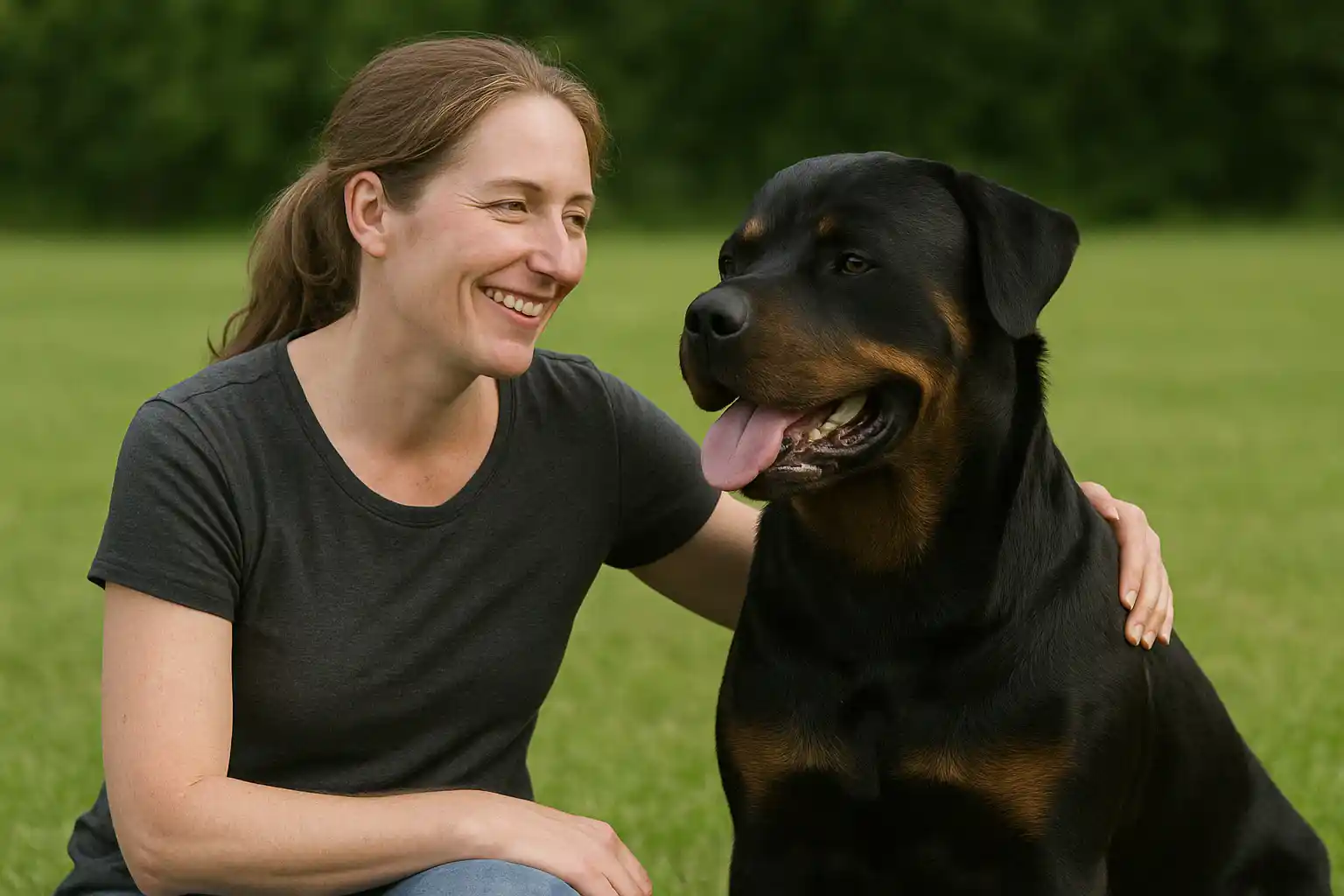
Conclusion
Learning how to take care of a Rottweiler properly is a significant commitment, but the rewards are immeasurable. These loyal, intelligent dogs thrive with proper nutrition, consistent training, appropriate exercise, and preventative healthcare. Most importantly, they need an owner who understands their unique needs and is committed to meeting them.
My journey with Zeus has taught me that Rottweilers don’t just need a caretaker – they need a leader, a friend, and a devoted advocate. When you provide the structure, care, and bond these magnificent dogs require, you’ll be rewarded with a loyal companion who will protect and love you with their entire being.
Successful Rottweiler ownership means embracing the responsibility that comes with a powerful, intelligent breed. These dogs are not for everyone – they need consistent handling, clear boundaries, and dedicated time for exercise and training. But for those willing to put in the effort to truly learn how to take care of a Rottweiler, they offer unparalleled loyalty, protection, and companionship.
It’s important to remember that learning how to take care of a Rottweiler is an ongoing process. These intelligent dogs need lifelong training reinforcement, mental stimulation, and adaptation of care as they age. Puppyhood requires establishing boundaries and socialization, adult years focus on maintaining training and physical condition, while senior care shifts toward joint support and monitoring for age-related health changes.
Public perception of Rottweilers can sometimes be challenging to navigate. By raising a well-trained, properly socialized Rottweiler, you become an ambassador for the breed. Zeus has changed many minds about Rottweilers through his gentle interactions with children, calm behavior in public, and impressive obedience. Being a responsible Rottweiler owner means not just providing excellent care but also representing the breed positively in your community.
Remember that each Rottweiler is an individual with their own personality and needs. The guidelines in this article provide a foundation, but the most important aspect of Rottweiler care is paying attention to your specific dog and adjusting your approach accordingly. With patience, consistency, and love, you’ll build a relationship with your Rottweiler that enriches both your lives. The journey of learning how to take care of a Rottweiler is challenging but infinitely rewarding – one I wouldn’t trade for anything.
FAQs About How to Take Care of a Rottweiler
How much exercise does a Rottweiler puppy need daily?
Rottweiler puppies need 5 minutes of exercise per month of age, twice daily. A 3-month-old puppy needs about 15 minutes of activity twice a day, focusing on mental stimulation and controlled play rather than forced exercise that could damage developing joints.
Are Rottweilers easy to take care of?
Rottweilers are not the easiest dogs to care for. They require consistent training, proper socialization, regular exercise (1-2 hours daily), and proactive health management. Their size, strength, and intelligence demand an experienced owner who understands how to take care of a Rottweiler’s specific needs. However, their loyalty and trainability make the effort worthwhile for dedicated owners.
What not to do to a Rottweiler?
Never use harsh punishment or physical discipline with Rottweilers as this damages trust and can trigger aggression. Avoid inconsistent training, neglecting socialization, leaving them alone for extended periods, or ignoring their exercise needs. Don’t feed them from elevated bowls (increases bloat risk), and never allow jumping or rough play during puppyhood which can damage developing joints.
What is a Rottweiler’s weakness?
Rottweilers’ main weaknesses include joint problems (hip/elbow dysplasia), heat sensitivity due to their black coat and muscular build, tendency toward bloat (gastric torsion), and potential for separation anxiety. They’re also prone to obesity which exacerbates joint issues. Learning how to take care of a Rottweiler properly includes managing these vulnerabilities through appropriate diet, exercise, and preventative healthcare.
Are Rottweilers high maintenance dogs?
Yes, Rottweilers are high maintenance in terms of training, exercise, and healthcare needs. They require daily physical and mental stimulation, consistent training throughout their lives, regular grooming despite short coats, and proactive health monitoring. The time and financial commitment to properly take care of a Rottweiler is significant, including potential costs for joint supplements, quality nutrition, and veterinary care.
How long do Rottweilers typically live?
Rottweilers typically live 8-10 years, though some may reach 12-13 with excellent care. Proper nutrition, weight management, regular veterinary care, and knowledge of how to take care of a Rottweiler’s health needs can help maximize their lifespan and quality of life. Large breeds generally have shorter lifespans, and Rottweilers are particularly prone to cancer, which can impact longevity.

